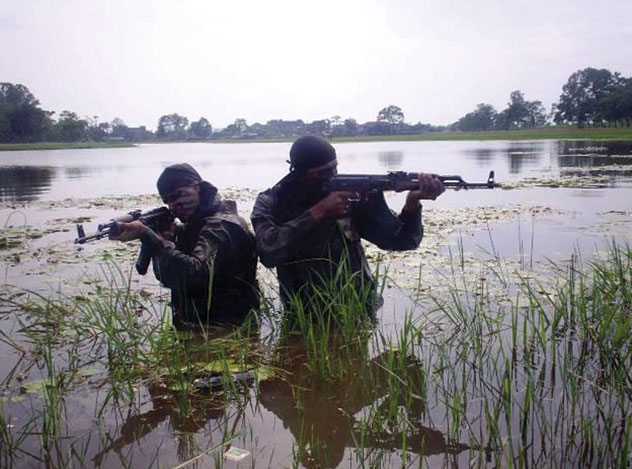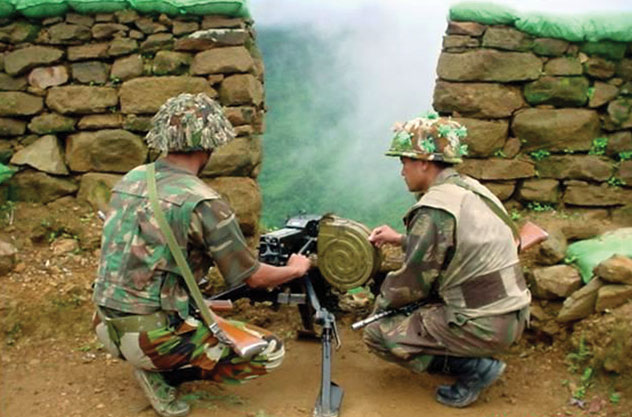SUBCONTINENT:
Discontent Troops: Turmoil in the Indian Army
Rising incidents of violent face-offs between officers and soldiers in the Indian Army are becoming a cause for worry for the establishment. The reasons are related to harsh working conditions, high risk to life due to nature of work, low pay, no leave and indifferent managing of lower ranks of Indian troops, writes Siddharth Srivastava.

(Above): Indian Army commandoes during a training exercise. [Photo: INDIAN ARMY]
At least three incidents of violence have been reported in the recent past prompting the defense minister and the Army’s top brass to conduct brainstorming sessions to prevent such occurrences from turning into a wider trend.
The latest instance of the standoff was at Samba in Jammu & Kashmir, triggered by the suicide of a military jawan. In May, a violent incident took place in Ladakh, while a similar fracas happened in June last year in Punjab.
Last month, Indian defense minister A.K. Antony publicly expressed concern about the brawls in the first official acknowledgement about the government’s worry over the issue. “Each incident is a matter of concern to me but armed forces are better trained to handle such situations. They are handling it in their own way. I also had a brief discussion with the Army chief and they are handling it,’’ Antony said.
Statistical evidence of suicide and fragging in the 1.1-million-strong Indian army points to growing levels of frustration among the jawans or soldiers. In 2003-05 suicides hovered around the 100 mark. It rose dramatically over the next three years to touch 150 in 2008. Since then, the number of suicides have gone down, but remain over 100 every year.
Multiple reasons have been attributed to the discontent. According to studies by the Defense Institute of Psychological Research (DIPR), the major causes of suicides in the army were domestic problems, marital discord, stress and financial problems. The report was quoted recently by Antony in Parliament.
Revelations of large-scale corruption in defense procurement, land and housing schemes in which top Army, civil officials and politicians have been found culpable, does not foster morale within the forces. A soldier is trained to follow orders. Doubts about the integrity of superior officers are a cause for dissonance.

(Above): Soldiers at outposts protecting the borders of India in the Northern territories. [Photo: INDIAN ARMY]
Psychological aspects relate to the Army being increasingly deployed in low intensity conflict zones in the North East, Jammu & Kashmir and lately extended to regions afflicted by leftist Maoist rebellions. It creates the peculiar situation of defense forces having to deal with multiple goals of eliminating the enemy while ensuring safety and retaining popular support of civilian population.
An Army soldier trained for all-out war situations is often found wanting in handling the emotional animosities of local populations that perceive security forces as instruments of state oppression and interference. In Kashmir, for example, even an inadvertent road accident could lead to riots across the state.
The same soldier ironically is feted by the country and turned into a hero when he succeeds, often posthumously or by sustaining grievous injuries, in killing terrorists as happened during the Mumbai Terror Attacks in November 2008 or fighting against a foreign enemy during the 1999 Kargil conflict.
In fact, along with the Army, growing incidence of suicides is being recorded in paramilitary forces, CRPF or the BSF, that are also deployed in high-risk internal conflict areas. The economic factors too cannot be ignored.

(Above): Soldiers at outposts protecting the borders of India in the Western territories. [Photo: INDIAN ARMY]
The bulk of soldiers continue to belong to rural areas that are undergoing rapid changes due to affects of urbanization and industrialization. A decade back, an Army man’s job was eulogized by folks back home for the sacrifices involved and economic stability that a regular salary provided.
Today the cost of living has risen much more than the wage increments. Given increase in land prices and other avenues of income, the Army has lost some of its sheen as a ‘sought after’ employer. A recent comment in the Indian media reads: “An objective review of the manner in which the pay, allowances and status of the military have been lowered over the last two decades reveals some startling facts. The average ‘fauji’ (army soldier) retires at a much younger age than the civilian counterpart who serves up to age 60. Many anomalies abound.”
Indeed, it is important for New Delhi to closely look for solutions to prevent the disgruntlement among jawans from turning to alarming levels. There is already rising instances of industrial unrest in India. Dissatisfied workers of automaker Maruti brutally assaulted management cadres recently, killing a senior executive and injuring several others. The Maoist violence in large tracts of Central and Eastern India is linked to mining companies exploiting the local tribal populations resulting in deep grievances.
Unlike neighbors Pakistan, Bangladesh or Nepal, the Indian army has remained largely apolitical and has worked well under the civilian political leadership since India’s independence in 1947. The Indian jawan deserves his due.
|